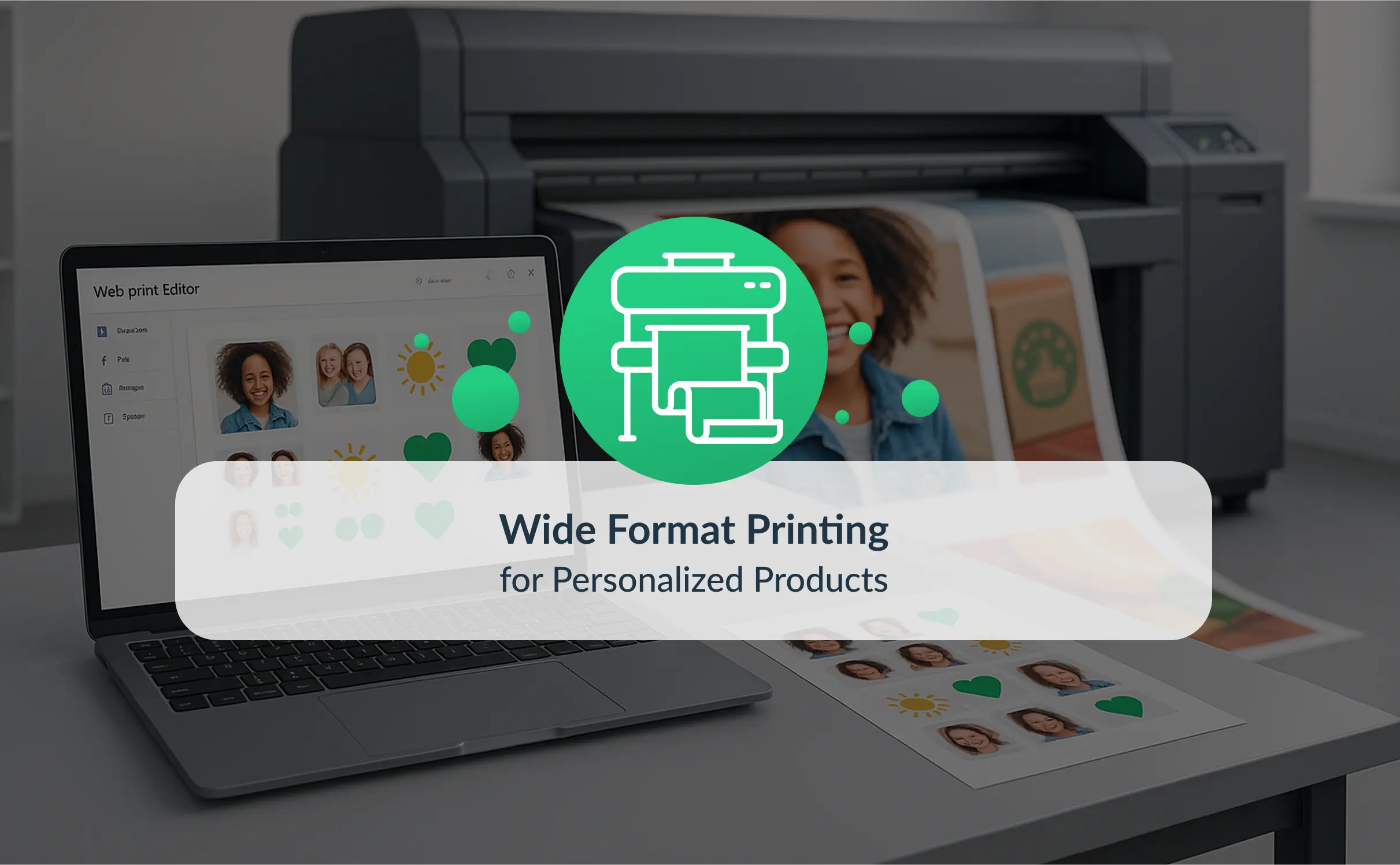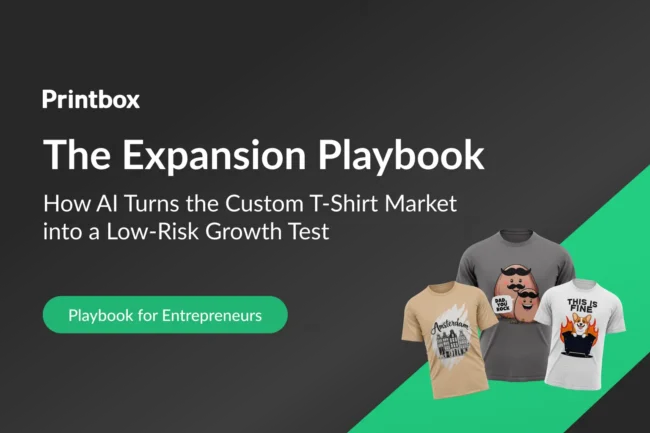Wide format printing is no longer just a technical term — it’s a strategic lever for personalization-first businesses looking to stand out. Whether you’re expanding into custom wall art, panoramic canvases, or oversized promotional pieces, scaling your offering starts with understanding both the technology and the opportunity. In this article, we’ll walk through the core benefits, common applications, and tools you need to turn wide format printing into a growth engine.
Today’s wide format printing services go far beyond “printing big”. They’re becoming a competitive differentiator for personalization businesses — especially when powered by cloud-based tools, real-time automation, and ERP integrations. This shift enables faster turnaround, higher margins, and full alignment between creative intent and operational execution.
What is Wide Format Printing?
At its core, wide format printing refers to any printing where the roll width exceeds traditional sizes — typically 24 inches and above. This capability unlocks new avenues for printing large visuals such as posters, banners, wall art, and other oversized personalized products. So, what does wide format printing mean in the context of modern product businesses? It’s the enabler of custom experiences at scale, allowing companies to go beyond standard formats without compromising consistency.
Historically seen as a niche capability, wide format printing has undergone a digital transformation. With today’s software capabilities and on-demand integration, it’s no longer siloed from the online ordering and personalization pipeline. Instead, it’s tightly woven into digital workflows, enabling personalized visuals to become finished products through automated, highly efficient processes. The key to unlocking this potential lies in understanding what is wide format printing and how it integrates end-to-end personalization.

How Does Wide Format Printing Work?
Wide format printing works by using inkjet technology to transfer digital files onto large-sized substrates — from paper and vinyl to canvas and fabric. Depending on the use case, printers may be aqueous, solvent, UV-curable, or latex-based. Speeds and resolutions vary, but what truly sets modern systems apart is how they integrate with digital ecosystems.
Here’s where wide format printing software becomes essential. Beyond basic RIP (Raster Image Processor) functionality, today’s software solutions offer customizable job queues, color management, cloud-based previews, and integration with workflow automation or ERP tools. These capabilities allow for a seamless bridge between what the customer personalizes online and what gets printed in production without bottlenecks or manual handoffs.
The market is seeing a rapid acceleration in demand for software-driven automation in wide format personalization. As Printbox, we see that companies increasingly seek solutions where preview generation, order validation, and print-ready file creation happen automatically — right inside their storefront’s front end. Tight coupling between e-commerce and production tools not only reduces errors but also frees up operators to focus on quality control and throughput.
By knitting together storefront personalization with production readiness through smart software, companies can confidently scale their wide format offerings without multiplying backend complexity.
The Benefits of Wide Format Printing
Wide format printing offers several business-critical advantages, especially for enterprise-level photo and personalization businesses aiming to differentiate and scale. First, it elevates product diversity: from multi-panel wall decor to panoramic prints, customization isn’t constrained by traditional sizing. Second, it supports high-resolution output even for large prints — thanks to wide format digital printing, where high DPI and color fidelity are optimized for super-sized formats without losing detail.
Scalability is another core benefit. Wide format printers, when integrated with smart software and ERP systems, can operate in semi- or fully automated production environments. This results in reduced turnaround times and better throughput, key for B2B providers handling large volumes or business clients with time-sensitive campaigns. High-performing wide format printing services are no longer a luxury but a requirement in scaling efficiently.
A growing number of players in the personalized photo sector are positioning wide format products — like multi-piece canvas sets or custom maps — as premium offerings. These items often carry higher margins due to their perceived value and emotional appeal. With the right e-commerce config tools and streamlined production, companies can deliver these products profitably at scale.
Lastly, personalized wide format products tap into an emotional resonance that small prints often don’t. They’re bold, visual, and often tied to meaningful spaces like homes or office environments. The business benefit? Higher average cart value and increased customer loyalty. Learn how to increase sales with personalized products.
Exploring the Applications of Wide Format Printing
Wide format printing is no longer limited to banners or commercial signage. In the B2B photo and gifting world, it’s powering a wide spectrum of personalized products such as:
- Custom wall art – from framed prints to photo canvases and peel-and-stick murals
- Oversized calendars or planners – often used in educational settings or as branded corporate gifts
- Personalized packaging – such as wraps for specialty boxes or shipping containers
- Specialty gifts – like large-format photo books and memorabilia panels
- Retail displays – point-of-purchase installations that combine brand visuals with personalized elements
Verticals such as retail, education, real estate, and hospitality are increasingly integrating wide format personalization because it aligns with brand storytelling and customer engagement strategies. Businesses leveraging wide format printing services in these industries can address both high-volume and bespoke production needs with a leaner, tech-enabled workflow.
So where can wide format printing shine brightest? Pretty much anywhere consumers crave high-quality, highly visible products.
Customer expectations are evolving toward larger, statement-making personalized products — especially in sectors like home decor and creative corporate gifting. We’re witnessing a clear movement toward offering these items in seasonal campaigns and limited editions. For businesses equipped with the right wide format infrastructure, this opens up recurring promotional cycles that keep customers coming back.
In parallel, environmental responsibility is gaining importance. From selecting substrate types to minimizing ink waste, decision-makers are looking holistically at sustainability. Explore sustainable printing practices to see how conscious choices in wide format printing can align with B2B procurement trends and customer values. Investing in eco-conscious wide format printing supplies can also boost your appeal among environmentally focused buyers seeking to align with green sourcing policies.
How to Sell More Wide Format Printing Services
Understanding how to sell more wide format printing isn’t simply about touting larger sizes — it’s about crafting the right value proposition for your clients. Whether you’re offering white-label services or selling branded photo products directly, the key lies in pairing creative flexibility with operational reliability.
Here are three proven strategies:
- Elevate the end-user experience: Offer 3D previews and live personalization tools that help shoppers envision the final product at scale. Let the output format inform the buying journey, not just the production side.
- Leverage workflow automation: Use wide format printing software that communicates seamlessly with ERP, CRM, and front-end systems. This builds trust and reliability into the fulfillment process, which is essential for B2B clients with strict deadlines.
- Position as a strategic partner: Don’t just offer printing — offer solutions. Educate clients on new vertically integrated offerings, such as combining photo product sales with physical signage, event backdrops, or promotional installations.
Among photo commerce brands, there’s increasing interest in using AI to streamline sales funnel decisions for wide format offerings — from recommending sizes based on uploaded images to dynamically adjusting layouts. This reflects a broader industry shift toward hyper-personalized shopping experiences. Leveraging AI for custom product businesses can enhance both conversion and output precision, especially for large-format products where alignment and scale are critical.
Ultimately, marketing wide format printing services means showing your clients what’s possible — and then delivering it flawlessly. The integration between online experience and physical output must feel natural, not bolted on. Personalization succeeds when technology, logistics, and storytelling align.
Ready to scale your wide format strategy?
Whether you’re launching personalized decor products or scaling wide format workflows across a B2B platform, the right tools make it effortless. Book a Printbox demo to explore how our end-to-end solution supports seamless personalization and back-end automation. Have questions about implementation or integration? Contact the Printbox team — we’re here to help craft a solution that works for your business.
What is wide format printing and why is it important for e-commerce?
Wide format printing refers to producing large-scale visuals like banners or wall art using specialized printers. It's crucial for e-commerce teams because it enables high-margin, customized products that set brands apart while supporting fast, scalable fulfillment.
How does wide format printing support product personalization?
Wide format printing, especially when paired with digital workflows, allows businesses to create unique, on-demand products like personalized photo canvases or decals, without long lead times or manual processes. This makes personalization efficient and profitable.
What are the benefits of using wide format printing software?
Wide format printing software automates order intake, proofing, and production, reducing errors and speeding up turnaround times. Integrated with e-commerce systems, it enables seamless personalization and optimized print workflows at scale.
Which industries can benefit from wide format printing applications?
Industries like retail, education, healthcare, and manufacturing benefit from wide format printing through branded wall graphics, functional prints like magnetic boards, or equipment wraps — all customized to fit their use cases and materials.
How can I sell more wide format printing services online?
To increase sales, focus on showcasing personalization features, software integration, and real-world applications. Use visual content, offer live previews, and simplify ordering with SaaS tools to position yourself as a strategic partner, not just a printer.
Is wide format printing cost-effective for custom orders?
Yes, digital wide format printing lowers setup costs and allows short runs with high customization, improving ROI. Automation reduces labor needs, while premium prices for personalized items help maintain strong profit margins.




